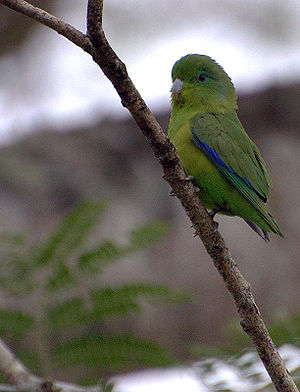Sparrow Parrots
| Sparrow Parrots | ||||||||||
|---|---|---|---|---|---|---|---|---|---|---|

Yellow-masked parrot ( F. xanthops ) |
||||||||||
| Systematics | ||||||||||
|
||||||||||
| Scientific name | ||||||||||
| Forpus | ||||||||||
| Boie , 1858 |
The parrot parrots ( Forpus ) are a genus of small parrots that belong to the New World parrots (Arini). The birds live from Mexico to the middle of South America .
Appearance
Sparrow parrots are short-tailed birds from 10 to 13 cm in length, only the yellow-masked parrot ( F. xanthops ) is slightly larger with 14-15 cm in length. The plumage is predominantly green or yellow-green in color. Only the males have bright blue plumage. The rump, neck and parts of the wings can be colored blue. when the wings are put on, their tips reach to the end of the tail.
Others
Several species are kept as pets , most commonly the blue-necked parrot ( F. coelestis ), which is also known as the blue-necked or gray-backed parrot in Switzerland and Austria. Keeping the parrots in pairs is essential. The minimum size of the aviary is 1m * 0.5m * 0.5m (lbh). There are now mutations in several species - especially in yellow, blue and piebald.
species
The genus consists of 7 species .
- Blue-rump Parrot ( F. cyanopygius ) ( Souancé , 1856)
- Green-rumped Parrot ( F. passerinus ) ( Linnaeus , 1758)
- Blue-winged Sparrow Parrot ( F. xanthopterygius ) ( von Spix , 1824)
- Ring-eye parrot ( F. conspicillatus ) ( Lafresnaye , 1848)
- Black-billed Parrot ( F. modestus ) ( Cabanis , 1849)
- Blue-necked Sparrow Parrot ( F. coelestis ) ( Lesson , 1847)
- Yellow-masked parrot ( F. xanthops ) ( Salvin , 1895)
Etymology and history of research
When Georges Cuvier introduced the new genus of the noble parakeets ( Psittacula ) in 1800 , parrot parrots were also classified in this genus. The Green-rumped Parrot and the Cuban Parakeet did not really fit into the new genus, but neither did they fit into the genus of the Macaw Parakeets ( Aratinga ). So a new genus was required.
There is no explanation for the etymology of the word Forpus . It has been assumed that it is composed of the Greek φορέω phoreō for "to carry something", "to be equipped with something" and πούς pous for "foot". Arthur Alfred Prestwich noted in his book I Name This Parrot. Brief biographies of men and women in whose honor commemorative names have been given the thesis that it could derive from the Latin “profus” for “to spread”, alluding to their short, wedge-shaped tails.
literature
- Dieter Hoppe : Parakeets and parrots. Verlag Eugen Ulmer, ISBN 3-8001-4452-2
- Friedrich Boie: Comments, observations and inquiries . In: Journal of Ornithology . tape 6 , no. 35 , 1858, pp. 359-366 ( online [accessed August 22, 2013]).
- Georges Cuvier: Leçons d'anatomie Comparée de G. Cuvier, Membre de L'Institut National, Professeur au Collège de France et à l'École centrale du Panthéon, etc. Recueillies et publiées sous ses yeux par C. Duméril, chef des travaux anatomiques de l'École de Médecine de Paris. tape 1 . Baudouin, Paris 1800 ( online [accessed August 22, 2013]). (Table at the end is missing)
- James A. Jobling: Helm Dictionary of Scientific Bird Names . Christopher Helm, London 2010, ISBN 978-1-4081-2501-4 .
Web links
- Tree of Life Web Project. Forpus . Version August 31, 2007. in The Tree of Life Web Project
Individual evidence
- ↑ IOC World Bird List - Parrots ( Memento of the original from August 6, 2012 in the Internet Archive ) Info: The archive link was automatically inserted and not yet checked. Please check the original and archive link according to the instructions and then remove this notice.
- ↑ Georges Cuvier, table in the appendix to volume 1.
- ↑ Friedrich Boie, p. 363.
- ↑ James A. Jobling, p. 163.